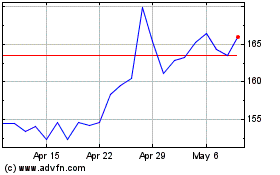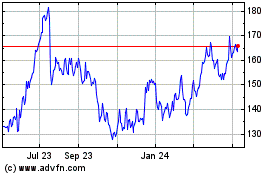By Jeffrey Sparshott
A sharp pullback in business investment and weak global demand
dragged down an already-lackluster U.S. economy in the opening
months of 2016, the latest setback in a bumpy expansion entering
its seventh year.
Consumers and the housing market kept the U.S. from sliding
backward, though only barely. Gross domestic product, the broadest
measure of economic output, advanced at a 0.5% seasonally adjusted
annual rate in the first quarter, the Commerce Department said
Thursday. That marked the economy's worst performance in two
years.
Corporate executives and economists say turmoil across global
financial markets in the opening weeks of the year may have
restrained U.S. economic activity, with conditions improving
somewhat after the Federal Reserve scaled back its expectations for
rate increases and commodity prices began stabilizing.
"While all is not well with the U.S. economy, neither is the
economy as moribund as the print on the first-quarter GDP report
implies," said Richard Moody, chief economist at Regions Financial
Corp. "Consumer spending and housing will provide the main support
going forward."
Slow first quarters followed by a rebound have been common in
recent years, leaving hope for better months ahead. The U.S.
economy contracted in the opening quarter of 2014 and barely grew
at the outset of 2015, only to bounce back and leave the economy on
the same staid trajectory seen during much of the expansion. For
all of 2015, GDP advanced 2.4%, the same as 2014.
Yet stronger global headwinds over the past year have served as
an added restraint. Among the forces working against the U.S.
expansion in recent months: Tepid demand from overseas and a strong
dollar have led to a drop in exports, subtracting from growth.
Cheap oil, meanwhile, has thrown business spending into disarray.
Outlays for mining exploration and wells contracted the most on
record in the first quarter.
The latest worry about the global outlook came Thursday when the
Bank of Japan surprised many investors by declining to launch fresh
stimulus measures despite a weak economic outlook. The BOJ and the
European Central Bank have been among the institutions pushing
interest rates into negative territory to boost their economies,
moves that had weakened their currencies and pushed the dollar
higher.
The Fed hasn't budged on interest rates since December, when it
raised its benchmark for the first time in nearly a decade. Fed
officials initially expected to raise interest rates by a full
percentage point this year, but in March downgraded their
expectation to just half a percentage point amid the global
economic turbulence.
After its latest meeting concluded Wednesday, the central bank
highlighted the domestic economy's mixed signals and remained
ambiguous about whether it would move its rate target from a range
of 0.25% to 0.5% in June.
Despite the cause for concern, the outlook isn't entirely bleak.
For example, business investment in computers, software, research
and development and nonenergy structures all rose during the first
quarter.
"In the U.S., just about any market that is away from oil is
doing pretty good," Doug Oberhelman, chairman and chief executive
of Caterpillar Inc., said last week.
Housing has been a particular bright spot, buoyed by low
interest rates and strong demand as more Americans find jobs.
Spending on residential investment, such as new-home construction
and home remodeling, climbed 14.8% in the first quarter, the
fastest pace since the end of 2012.
"All the macroeconomic indicators that we look at for our
business are all green," said Todd Bluedorn, chairman and CEO of
Lennox International Inc., a manufacturer of heating and cooling
systems. "So I think consumers are ready to spend money."
The labor market has been especially robust. U.S. payrolls have
grown by an average of 234,000 a month over the past year, layoffs
are near their lowest level in more than 40 years and wages are
showing some signs of acceleration.
"Do we expect the U.S. economy to perform at higher growth rates
in the quarters ahead? We do," Arne Sorenson, president and CEO of
Marriott International Inc., said Thursday. "It seems reasonably
clear that sentiment was profoundly negative early in this year and
that it has improved significantly since January."
Still, while the first-quarter slowdown was predicted and a
second-quarter rebound is expected, it isn't assured. GDP growth
has deteriorated steadily since hitting a 3.9% pace in the second
quarter of 2015. The economy expanded at a 2% pace in the third
quarter and 1.4% in the fourth quarter of last year.
Consumer spending, which accounts for more than two-thirds of
economic output, has been decelerating for three consecutive
quarters. Relatively low gasoline prices and steady job gains
apparently haven't been enough to spur consumers to splurge instead
of save.
Taken together, those trends have crimped corporate profits. The
S&P 500 is likely to mark a third consecutive quarter of
declining earnings, the longest streak since the financial
crisis.
Business at Vermeer Corp. reflects some of the broader forces
playing out across the global economy. The Pella, Iowa, firm
manufactures equipment used in agriculture and mining, two sectors
buffeted by a precipitous fall in commodity prices.
The company's exports have been crimped by a strong dollar and
slow growth overseas. But domestic demand for machinery used in
waste processing, utility work and home landscaping remains robust
alongside steady gains for the housing market. That should allow
the family-owned firm to remain on steady footing as the economic
ground beneath continues to shift, said Jason Andringa, Vermeer's
president and CEO.
But expectations remain subdued. "I don't think we aspire to
more than moderate growth at this point," Mr. Andringa said.
Write to Jeffrey Sparshott at jeffrey.sparshott@wsj.com
(END) Dow Jones Newswires
April 28, 2016 18:20 ET (22:20 GMT)
Copyright (c) 2016 Dow Jones & Company, Inc.
AutoNation (NYSE:AN)
Historical Stock Chart
From Mar 2024 to Apr 2024

AutoNation (NYSE:AN)
Historical Stock Chart
From Apr 2023 to Apr 2024
